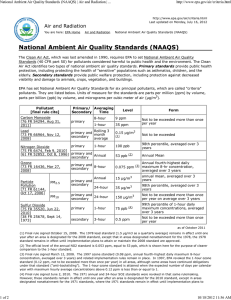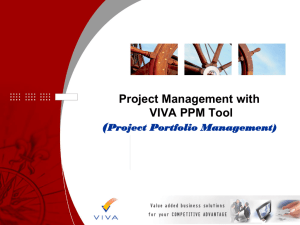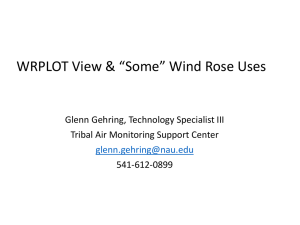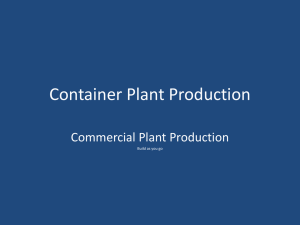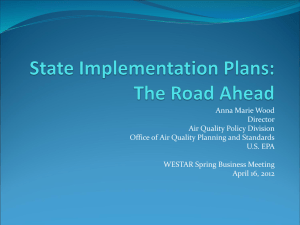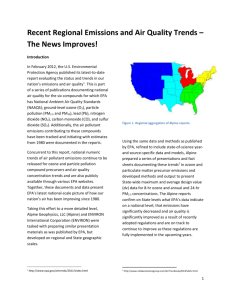Division of Air Quality / NJ Air Program Update - Mid
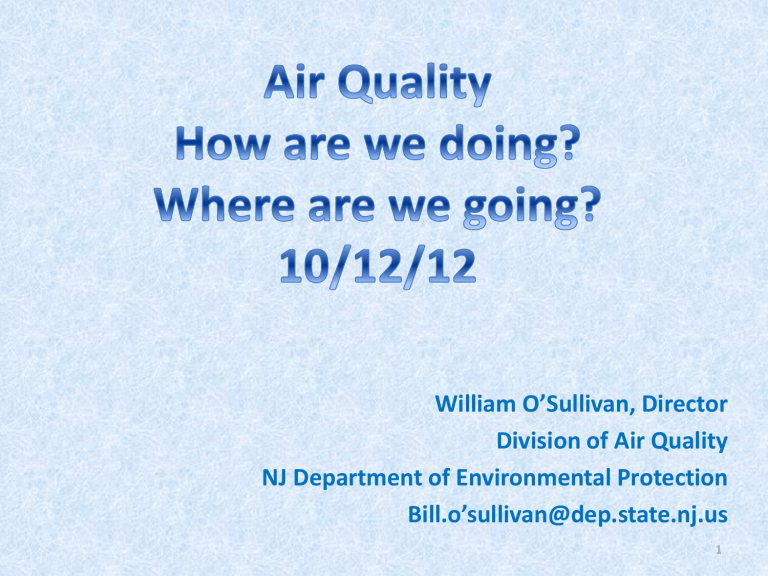
William O’Sullivan, Director
Division of Air Quality
NJ Department of Environmental Protection
Bill.o’sullivan@dep.state.nj.us
1
Origin of Air Pollution Control Requirements
1. Federal Clean Air Act – Unlikely to change soon
2. Federal EPA rules – many in progress, some delayed
3. States – primary responsibility for attaining health standards
4. Regional Strategies
– Needed for regional problems
– Ozone Transport Commission (Example)
– State Rules still needed
– Interstate transport of Air Pollution – significant impacts on health exceedances are prohibited
5. Local governments/Communities
– More involvement
– Cumulative impacts and EJ
6
Pollutant
CO
Lead
NO2
PM10
PM2.5
Ozone
SO2
Existing NAAQS and New Jersey Status
Primary Standards
Level
9 ppm
35 ppm
New monitors
Date
1971
1971
2011
Averaging Time
8-hour
1-hour
Monitoring Data
Status
Attaining
Likely to Attain
Designation/SIP Status
Attainment/Last Maintenance
Plan in progress
No new Requirements
1.5 µg/m3 1978 Quarterly Average Attaining Attainment
0.15 µg/m3 2008
1971
Rolling 3-Month
Average
Annual
Attaining
Attaining
Unclassifiable-Attainment
Attainment 53 ppb
100 ppb and New monitors
150 µg/m3
2010
1987
1-hour
24-hour
Likely to Attain Unclassifiable-Attainment
15.0 µg/m3
35 µg/m3
0.12 ppm
0.08 ppm
0.075 ppm
0.03 ppm
0.14 ppm
75 ppb
1997
2006
1979
1997
2008
1971
1971
2010
Annual
24-hour
1-hour
8-hour
8-hour
Annual
24-hour
1-hour
Attaining
Attaining
Attaining
Attaining
Attaining
Not Attaining
Attaining except for
Columbia
Attainment
Nonattainment/ Redesignation requested
Nonattainment/ Redesignation requested
Standard revoked/CDDs final
Nonattainment/CDDs final
Nonattainment
Attainment except for Warren
County
State designation recommendations - NA for 61 municipalities in 4 counties/unclassifiable rest of state
8
Anticipated National Ambient Air Quality Standards Milestones and Regional Haze
Pollutant Standard
NAAQS
Promulgation
Date
Designations
Effective
110(a) SIPs
Due
Attainment
Demonstration/
NAA SIP Due
Attainment
Date
Promulgated
PM2.5
35 µg/m3 daily
Ozone
0.075 ppm 8 hour
Lead 0.15 µg/m3
NO2 Primary 100 ppb 1 hour
SO2 Primary 75 ppb 1 hour
CO
9 ppm 8 hour,
35 ppm 1 hour
CO
No change, new monitoring
NO2/SO2
Secondary
No change
Sep-06
Mar-08
Oct-08
Jan-10
Jun-10
1971
Aug-11
Mar-2012
Dec-09
Jul-12
Dec-11
Feb-12
Aug-13?
NA
NA
NA
Sep-09
(Done)
Mar-11
Oct-11
Jan-13
Jun-13?
NA
Dec-12, CDD in progress instead
Dec-14
Marginal Inventory/
RACT: Jul-14
Moderate: Jul-15
Marginal: Dec-15
Moderate: Dec-18
NA
NA
Jan-14?
Maint Plan
Oct-10
NA
NA
Aug-18?
NA
NA NA
NA
NA
NA
Regional Haze Visibility FTS eff. Jan-09 NA
NA
Progress
Report
Jul-14
Dec-2018 NA
Not Yet Promulgated-Anticipated Schedule
PM2.5
12-13 µg/m3 annual
Proposed Jun-
12, Final Dec-
12?
Ozone
New 8-hour
??? ppm
Jun-14?
Early 2015?
Jul-16?
2015?
Jun-16?
2018?
Jul-19?
2020-25?
Jul-24?
9
10
Recent Successes
1. Much lower Fine Particles
– Well below current NAAQS
2. Lower Ozone
– At 85 ppb NAAQS
3. Declining Air Toxics Levels
11
Challenges
1.
Fine Particles - continue improvement
– Avoid nonattainment of lower NAAQS
(Scheduled December 2012)
2.
Ozone – exceeds 75 ppb ozone NAAQS
– 2015 attainment deadline for 75ppb NAAQS
– Could exceed 85ppb NAAQS with hot summers (Did in 2012)
– New NAAQS (60 to 70ppb) expected in 2014
3.
Air Toxics – Risks still high
– Primarily Motor Vehicles
– Diesel Dominates Risk
– Cumulative Risk
– Disproportionate Risk - EJ
12
Focus on Particles
1. Clean Data Determinations - Air Quality now better than current NAAQS
2. Attainment Designations in progress – need to demonstrate maintenance of the NAAQS
(10 years)
3. PM offsets - continue until redesignation
- interpollutant offsets possible
4. New NAAQS – December 2012 EPA commitment
5. Need to continue fine particle downward trend
– to avoid exceedances of new NAAQS
14
New Jersey’s Multi-State PM
2.5
Nonattainment Areas
15
16
17
18
Wood Smoke
1. Primary Cause of Nonattainment in Rural States
2. Growing Air Quality Problem in Northeast
3. Outdoor Wood Burners
• Neighborhood Nuisance
• NJDEP Enforcement – No visible smoke standard
4. Wood Stoves
• Draft Federal standards for new stoves
• Will not solve misuse
• Will not address existing stoves
5. NJ Suburbs and Rural Areas
• Future exceedances of health standards?
• No burn days?
• Woodstove changeout Programs?
19
Sulfur Dioxide
1. Criteria Pollutant – Health and Welfare NAAQS
2. Converts to Sulfates – Major component of Fine Particles
(Precursor)
3. Causes haze – Brigantine Wildlife Refuge (Class 1 area for visibility)
4. Causes acid rain – kills fish, damages plants and structures
21
22
Sulfur Dioxide
1. NJ Dominated by Coal in 2009 (10 units)
• 4 Units – had scrubbers prior to 2009 (1 will cease coal use in 2015)
• 2 Units – ceased coal use in 2010
• 3 Units – scrubbers operational in 2010
• 1 Unit – will cease coal use in 2013
2. NJ Sulfur in Home Heating Oil Limits
• 2000 ppm now
• 500 ppm in 2014
• 15 ppm in 2016
3. Diesel – EPA Rules
• 15 ppm phased in over last 5 years
Result – Dramatic decrease in S0
2 and sulfates
Challenge – Coal in other states
23
Out of State Powerplants
1. EPA Prevention of Significant Deterioration Cases
• Air Pollution Control Technology Focus
• Seek Best Available Control Technology
• Examples – Ohio Edison, Homer City, Allegheny, GenOn
2. Clean Air Act Section 126 Petitions
• Health Standard focus
• Seek emission reduction sufficient to avoid exceedances of health standard
• GenOn Portland example
3. EPA Mercury and Air Toxics (MAT) Rules
• Indirectly controls SO
2
4. EPA Cross State Air Pollution Rule (CSAPR) – Court
Overturned
• SO
2
– generally effective caps
• NOx – not sufficient for 75 ppb ozone
24
Table 1
Comparison of Allowable Short-Term Emissions between the 400 MW Coal-Fired Portland Power
Plant and the Proposed 655 MW Natural Gas Fired Newark Energy Center
Max. Allowable Emissions (lbs/hr)
Pollutant
Sulfur Dioxide
Nitrogen Oxides
Particulate (TSP)
Portland
Coal Units
14,720
2,070
416.9
NEC
Gas Turbines
5.6
33.6
15.8
Normalized Max. Allowable Emissions
(lbs/MWhr)
Portland NEC
Coal Units
36.80
5.18
1.04
Gas Turbines
0.009
0.051
0.024
Pollutant
Sulfur Dioxide
Nitrogen Oxides
Particulate (TSP)
Portland Coal Units 2007-2010
Actual Annual Emissions
(tons per year)
29,067
3,321
295.5
NEC Gas Turbines Allowable
(tons per year)
19.7
136.9
57.27
26
NJ Ozone Nonattainment
28
29
30
Number of Days Ozone Standards
Have Been Exceeded in New Jesey
2000 - 2012*
* Data through Sept 21, 2012
70
64
60
52
>0.12 ppm (1-Hour Max)
>0.08 ppm (8-Hour Max)
>0.075 ppm (8-Hour Max)
50
45
44
41
40
39
35
34
36
35
30 30
30
20
10
0
4
18
2000
11
2001
23 23 23
20
21
16
18
17
13
14
11
9 9
2002
4
2003
0
2004
5
2005
3
2006
3
2007
0
2008
0
1
2009
1
2010
0
2011
0
2012
32
33
34
35
OTC States
36
Ozone Transport Commission (OTC)
Regional Control Strategies
NO x
Sources:
VOC Sources:
Model Rules/MOUs:
1.
EGU’s (Oil and Gas-fired Boilers) *
2.
High Electric Demand Day (HEDD)
Turbines *
3.
New Small Boilers
4.
Stationary Generators
Model Rules/MOUs:
1.
Large VOC Stationary Storage
Tanks *
2.
Autobody Refinishing
3.
Consumer Products
4.
Architectural/Industrial Coatings
Draft Model Rules:
5.
6.
Non-Road Equipment Idling *
Natural Gas Compressor Stations
Draft Model Rules:
5.
Solvent Cleaning
(Industrial/Commercial)
6.
Paint Thinners (Consumer)
Categories Under Review:
7. Municipal Waste Incinerators
8.
Promote Energy Efficiency/
Renewable Energy
9.
Coal-fired Boilers (EPA)
Category Under Review:
7.
Stage 1 and 2 Vapor Recovery
*Existing NJ Rule Equivalent to Model Already Adopted
Mobile Sources
Significant contributors to Ozone,
Toxics, PM2.5, GHG
38
40
41
42
Diesel Emission Reduction Efforts
1. Mandatory Retrofit Law
• In last phase – DPWs and miscellaneous on and off-road public diesel vehicles
2. Private off-road construction vehicles
• Implementing EO60
• 175 vehicle pilot program
• Retrofits of certain engines used on state contracts
3.
Ports
• Trucks, ships, cargo handlers, cranes, trains, tugs
• NJ NY Port Authority diesel emission reduction plan
• Other ports also reducing emission (Camden, other states)
• EPA 2015 sulfur limit for oil used by ships
4. Diesel I/M Program
44
Continued – Diesel Emission
Reduction Efforts
4. Stationary diesels
• NOx RACT Rules
• Cancer risk management with construction permits
• Model fine particles and NO
2
NAAQS
5. Emergency Electricity Diesels
• Limited to blackouts and brownouts
• Can be used for peaking or DSM only if well controlled
(NOx and PM)
45
46
47
Summary
Where Do Emissions Need to Decrease?
1. Ozone
• Vehicles – VOC & NOx
• Area Sources - VOC
• Point Sources – Out of State NOx
2. Particles
• Wood Smoke
• Diesel Engines – Especially NonRoad
• Area Sources – Small Engines
• Out of State S0
2 and PM
3. Air Toxics
• Diesels
• Small Neighborhood Sources
▫ Dry Cleaners
▫ Autobody Repair/Painting
• Gasoline
▫ New Vehicles
▫ Maintain Existing Vehicles
49
Division of Air Quality Website: http://www.nj.gov/dep/daq/ (links to programs, regulations and other topics found here)
Air Quality Permitting Program: http://www.state.nj.us/dep/aqpp/ (applications, forms, testing information, etc.)
Bureau of Air Quality Planning: http://www.state.nj.us/dep/baqp/ (State Implementation Plans
(SIPs), inventory, etc.)
Bureau of Air Monitoring: http://www.njaqinow.net/Default.ltr.aspx
(monitoring data, NJ air quality forecast)
Bureau of Mobile Sources: http://www.nj.gov/dep/stopthesoot/
USEPA Greenbook for Nonattainment areas: http://epa.gov/oar/oaqps/greenbk/ (nationwide information on nonattainment areas and classifications for criteria pollutants)
USEPA State Implementation Plan Status and information: http://www.epa.gov/air/urbanair/sipstatus/
ISG notices come out on AQPP Listserv. Subscribing to Listserv can be found at : http://www.state.nj.us/dep/aqpp/listserv.html
AirNow: http://www.airnow.gov/ (air quality forecasts)
50
